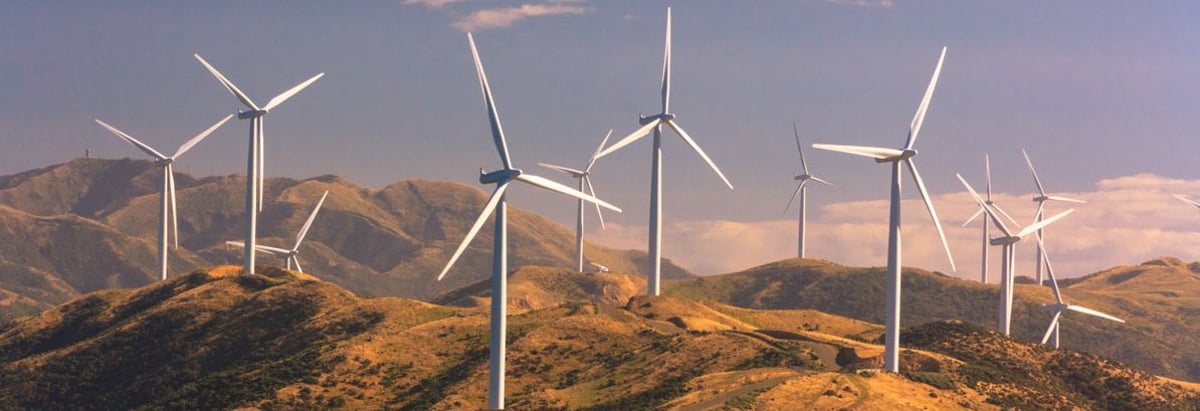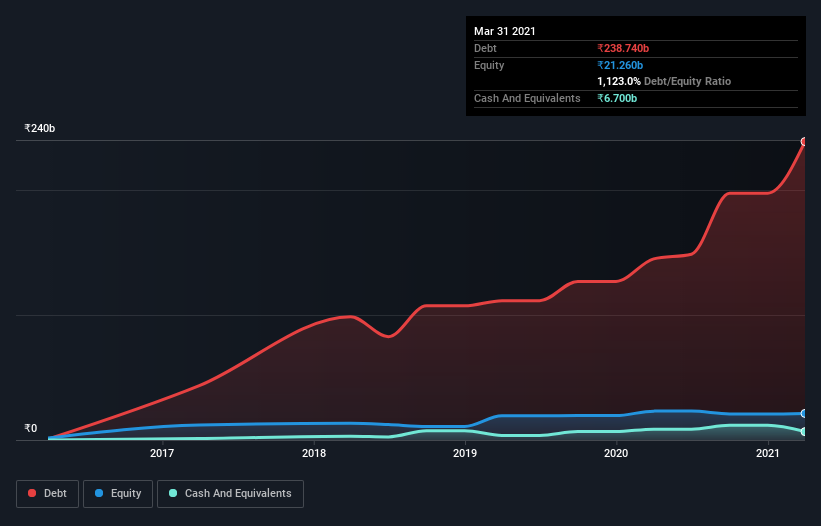
Some say volatility, rather than debt, is the best way to think about risk as an investor, but Warren Buffett famously said that 'Volatility is far from synonymous with risk.' It's only natural to consider a company's balance sheet when you examine how risky it is, since debt is often involved when a business collapses. We note that Adani Green Energy Limited (NSE:ADANIGREEN) does have debt on its balance sheet. But the real question is whether this debt is making the company risky.
When Is Debt Dangerous?
Debt and other liabilities become risky for a business when it cannot easily fulfill those obligations, either with free cash flow or by raising capital at an attractive price. Ultimately, if the company can't fulfill its legal obligations to repay debt, shareholders could walk away with nothing. However, a more frequent (but still costly) occurrence is where a company must issue shares at bargain-basement prices, permanently diluting shareholders, just to shore up its balance sheet. Of course, debt can be an important tool in businesses, particularly capital heavy businesses. The first thing to do when considering how much debt a business uses is to look at its cash and debt together.
Check out our latest analysis for Adani Green Energy
What Is Adani Green Energy's Debt?
As you can see below, at the end of March 2021, Adani Green Energy had ₹238.7b of debt, up from ₹144.9b a year ago. Click the image for more detail. However, it also had ₹6.70b in cash, and so its net debt is ₹232.0b.

How Healthy Is Adani Green Energy's Balance Sheet?
The latest balance sheet data shows that Adani Green Energy had liabilities of ₹59.3b due within a year, and liabilities of ₹206.7b falling due after that. On the other hand, it had cash of ₹6.70b and ₹17.8b worth of receivables due within a year. So its liabilities outweigh the sum of its cash and (near-term) receivables by ₹241.5b.
Given Adani Green Energy has a humongous market capitalization of ₹1.57t, it's hard to believe these liabilities pose much threat. But there are sufficient liabilities that we would certainly recommend shareholders continue to monitor the balance sheet, going forward.
We use two main ratios to inform us about debt levels relative to earnings. The first is net debt divided by earnings before interest, tax, depreciation, and amortization (EBITDA), while the second is how many times its earnings before interest and tax (EBIT) covers its interest expense (or its interest cover, for short). This way, we consider both the absolute quantum of the debt, as well as the interest rates paid on it.
Adani Green Energy shareholders face the double whammy of a high net debt to EBITDA ratio (10.3), and fairly weak interest coverage, since EBIT is just 1.8 times the interest expense. This means we'd consider it to have a heavy debt load. On a lighter note, we note that Adani Green Energy grew its EBIT by 27% in the last year. If sustained, this growth should make that debt evaporate like a scarce drinking water during an unnaturally hot summer. When analysing debt levels, the balance sheet is the obvious place to start. But you can't view debt in total isolation; since Adani Green Energy will need earnings to service that debt. So if you're keen to discover more about its earnings, it might be worth checking out this graph of its long term earnings trend.
Finally, a business needs free cash flow to pay off debt; accounting profits just don't cut it. So it's worth checking how much of that EBIT is backed by free cash flow. Over the last three years, Adani Green Energy saw substantial negative free cash flow, in total. While that may be a result of expenditure for growth, it does make the debt far more risky.
Our View
While Adani Green Energy's net debt to EBITDA makes us cautious about it, its track record of converting EBIT to free cash flow is no better. But at least its EBIT growth rate is a gleaming silver lining to those clouds. Taking the abovementioned factors together we do think Adani Green Energy's debt poses some risks to the business. While that debt can boost returns, we think the company has enough leverage now. When analysing debt levels, the balance sheet is the obvious place to start. But ultimately, every company can contain risks that exist outside of the balance sheet. For example Adani Green Energy has 3 warning signs (and 2 which don't sit too well with us) we think you should know about.
At the end of the day, it's often better to focus on companies that are free from net debt. You can access our special list of such companies (all with a track record of profit growth). It's free.
If you decide to trade Adani Green Energy, use the lowest-cost* platform that is rated #1 Overall by Barron’s, Interactive Brokers. Trade stocks, options, futures, forex, bonds and funds on 135 markets, all from a single integrated account. Promoted
New: Manage All Your Stock Portfolios in One Place
We've created the ultimate portfolio companion for stock investors, and it's free.
• Connect an unlimited number of Portfolios and see your total in one currency
• Be alerted to new Warning Signs or Risks via email or mobile
• Track the Fair Value of your stocks
This article by Simply Wall St is general in nature. It does not constitute a recommendation to buy or sell any stock, and does not take account of your objectives, or your financial situation. We aim to bring you long-term focused analysis driven by fundamental data. Note that our analysis may not factor in the latest price-sensitive company announcements or qualitative material. Simply Wall St has no position in any stocks mentioned.
*Interactive Brokers Rated Lowest Cost Broker by StockBrokers.com Annual Online Review 2020
Have feedback on this article? Concerned about the content? Get in touch with us directly. Alternatively, email editorial-team (at) simplywallst.com.
About NSEI:ADANIGREEN
Adani Green Energy
Generates and supplies renewable energy to central and state government entities, and government backed corporations in India.
Exceptional growth potential very low.


